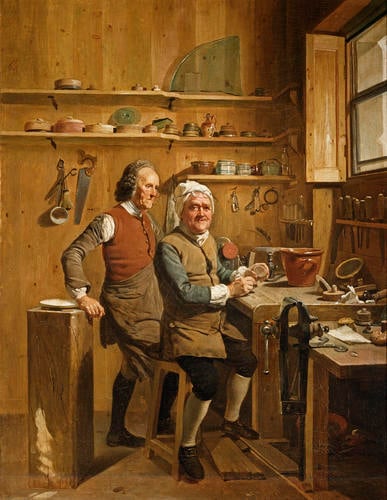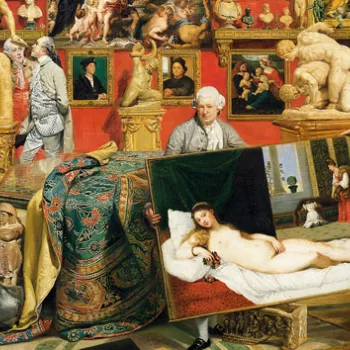John Cuff Signed and dated 1772
Oil on canvas | 89.8 x 70.0 cm (support, canvas/panel/stretcher external) | RCIN 404434
-
The first work Zoffany exhibited in England, at the Society of Arts in 1762, was an image of David Garrick (1717-79) in The Farmer’s Return; the first work he exhibited at the Royal Academy, in 1770, depicted Garrick playing the part of Abel Drugger in Ben Jonson’s Alchemist (private collection). Sir Joshua Reynolds bought this latter painting for 100 guineas and was immediately offered 120 guineas for it by the Earl of Carlisle. Zoffany’s Garrick as Abel Drugger is a parody of an alchemist scene by David Teniers, of which there are many examples: Zoffany treats a seventeenth-century English satire on the fraudulence and vanity of alchemy through the lens of a seventeenth-century Flemish treatment of the same subject. David Garrick spotted the same connection when, in his Essay on Acting of 1744, he wrote of the postures required to play the part of Abel Drugger so as to present ‘the compleatest low Picture of Grotesque Terror that can be imagin’d by a Dutch Painter.’ (English connoisseurs of the period made little distinction between Dutch and Flemish masters). Just as the elegant and intellectual Garrick gained the highest praise for playing this clumsy and gullible clown, so the erudite Zoffany shows that he can similarly stoop to mimic low-life Flemish painting to brilliant comic effect. It is possible that Reynolds had Zoffany’s painting in mind when he delivered his sixth Discourse at the Royal Academy on 10 December 1774; having discussed lesser artists of the Dutch school, such as Adriaen Brouwer and Jan Steen, he suggested that ‘though they cannot be recommended to be exactly imitated, [they] may yet invite an artist to endeavour to transfer, by a kind of parody, their excellencies to his own performances.’
Reynolds had not yet made this pronouncement when, in 1772, George III commissioned Zoffany to depict Mr Cuff, (c.1708-72) a Fleet Street optician from whom he obtained microscopes, but Zoffany hardly needed the hint. This painting is the most perfectly observed parody in art: Zoffany has exactly caught the dingy colour-code of a Teniers Alchemist scene, the awkwardness of tortoise-skinned, leather-aproned mechanics; the absurd clutter of incomprehensible pots, pans, tools and widgets; the daylight from a single window planting a droplet of light on each coarse but lovingly-rendered surface.
Zoffany turns the joke on its head: Teniers’s Alchemists look benighted and confused, while Mr Cuff is cheerful and manifestly competent. Alchemists are symbols of scientific superstition, while Cuff’s telescopes, microscopes and spectacles help one to see the real world. His workshop is not even confusing to the initiated: historians of science have shown that his shelves contain an orderly arrangement of grinding tools and crown glass; he himself is grinding a lens with a lathe operated by a treadle; his hair and arms are protected from glass dust by a headdress and special cuffs. This is an optician’s painting, a loving celebration of the phenomenon of light, a tribute to the patient technicians of the Enlightenment.
Signed and dated: Zoffany pinx / 1772
Text adapted from The Conversation Piece: Scenes of fashionable life, London, 2009Provenance
Purchased by or painted for George III; recorded in Princess Augusta's Bedroom at Kew Palace in 1805
-
Creator(s)
Acquirer(s)
-
Medium and techniques
Oil on canvas
Measurements
89.8 x 70.0 cm (support, canvas/panel/stretcher external)
107.3 x 87.3 x 8.3 cm (frame, external)
Category
Object type(s)
Other number(s)
Alternative title(s)
Peter Dolland (b. 1731), previously identified as
The Lapidaries
An optician with his attendant
John Cuff and his Assistant









